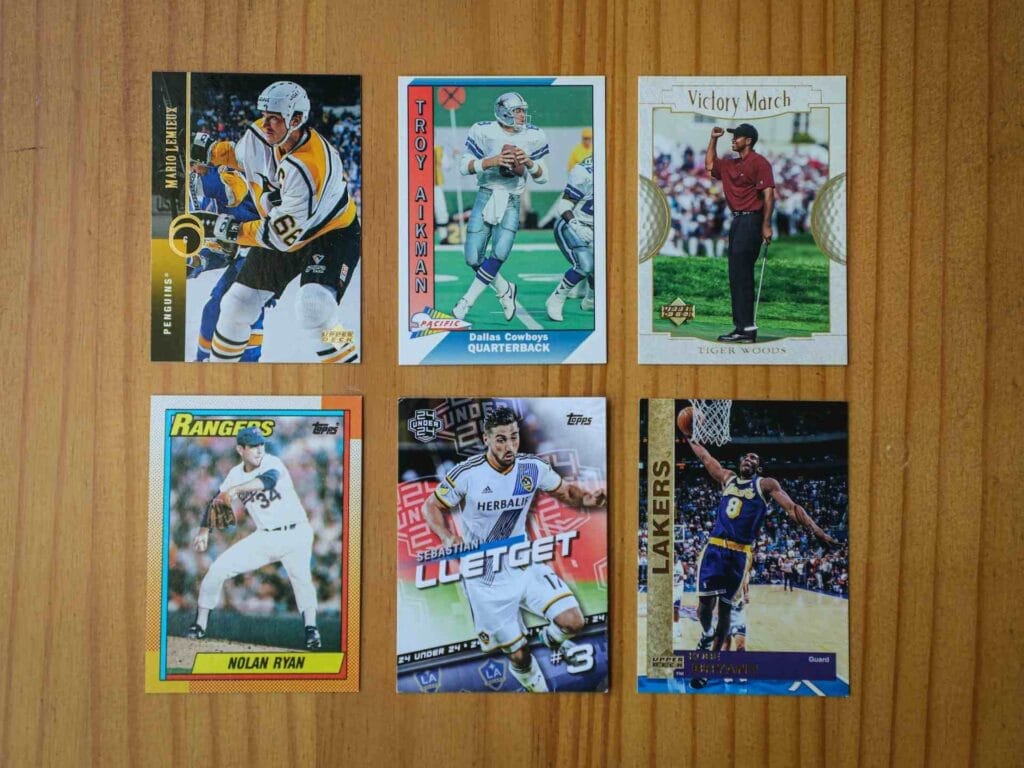
Introduction
Welcome, rookie collectors and seasoned traders alike! In the vast world of trading cards—a universe filled with rare collectibles, treasured childhood memories, and potentially lucrative investments—it’s easy to feel lost. But fret not! By the time you finish reading this guide, you’ll have a solid understanding of the ins and outs of the main types of trading cards: sports, gaming, and collectibles. Ready to embark on your journey into the diverse world of trading cards? Let’s dive in!
The Basics of Trading Cards
Trading cards, those pocket-sized pieces of cardboard, hold a universe of fascination. But what exactly are they? Let’s break it down.
Trading cards, as the name suggests, are small cards designed for collecting and trading. They originated in the 19th century, tucked into cigarette packs as a marketing gimmick. Fast forward to today, and they’ve evolved into a multi-billion dollar industry, with cards spanning a multitude of themes and interests.
People collect all types of trading cards for a variety of reasons. Some are drawn to the thrill of the hunt, seeking out rare and valuable cards. Others enjoy the social aspect, trading with friends and fellow collectors. And then there are those who see trading cards as an investment, banking on their value increasing over time.
Regardless of the reason, one thing remains constant: every trading card tells a story. Whether it’s a sports card showcasing a player’s stats, a gaming card detailing a mythical creature’s abilities, or a collectible card capturing a moment from a beloved movie, each card offers a glimpse into a larger world.
Now that we’ve covered the basics, let’s delve deeper into the different types of trading cards. Whether you’re a sports fanatic, a gaming enthusiast, or a pop culture aficionado, there’s a trading card out there for you. Ready to explore? Onward we go!
Delving Deep into Different Types of Trading Cards
Trading cards encompass varied interests and hobbies, with each card type offering a unique collecting journey that could significantly influence the value of your collection. Let’s dive into this list of the main types of trading cards.
Sports Cards
Sports trading cards or sports cards, as they are popularly known, made their initial appearance around the year 1886. These cards, released by Goodwin Tobacco, were a part of a baseball card set featuring 12 players from the New York Giants, and were known as the N167 set. Interestingly these cards were more than just collector’s items back in the day, as they were designed to stiffen the packaging of tobacco products they accompanied.
Presently, major sports leagues in the United States, including the National Football League (NFL), National Basketball Association (NBA), National Hockey League (NHL), Major League Baseball (MLB), etc., have exclusive contracts with singular card manufacturing firms to produce these cards.
Sportscards can be quite standardized in their design. Typically, the front side of the card features an image of the player, their name and the team they represent, along with player statistics. On the flip side, you’d often find more biographical information, additional stats and sometimes decorative flourishes.
Here is a brief list of some notable sports trading cards:
- Mickey Mantle, 1952 Topps: Known as one of the “Holy Grails” of sports card collecting, this features Mantle in his New York Yankees uniform and is one of the most sought-after sports trading cards.
- Michael Jordan, 1986-87 Fleer Rookie Card: Known as his official rookie card, it’s one of the most iconic sports cards and can fetch a high value in mint condition.
- Wayne Gretzky, 1979 O-Pee-Chee Rookie Card: Gretzky’s rookie card remains the most valuable hockey card of all time, especially in perfect condition.
Sports cards have seen a surge in market value in recent years and have grown in popularity as an interesting asset for investment and the main type of trading cards in many markets. However, making successful investments in this field calls for a deep knowledge of the sport, player potential and career trajectory.
Non-Sports Cards
The inception of non-sports trading cards can be traced back to the late 19th century when companies started including them in cigarette packs or bubble-gum packets. A diverse mix of themes bedecked these cards, from exotic wildlife and celebrated entertainment figures to landmarks around the globe, providing an educational or entertainment spin to the product they accompanied.
Through the 1950s, these distinct cards gained momentum, finding many takers amongst collectors. Between the late 60s and mid-70s, the Topps company led an interesting shift in the concept of these cards by introducing Wacky Packages, a series of cards that parodied everyday consumer products. This innovative idea resonated with the public, amplifying the popularity of non-sports cards and becoming one of the most sought after types of trading cards.
Many non-sports cards drew inspiration from popular culture, such as popular movies and TV series. Think Star Trek, Lord of the Rings, Disney movies, Planet of the Apes, and you will get an idea of how these cards maneuvered their way into the hearts of collectors. Comic books formed another vivacious source theme, giving rise to much-loved cards featuring characters from Marvel and DC universes.
While discussing these cards, some intriguing examples come to mind. The ‘Garbage Pail Kids’ cards, released by Topps in the 1980s, were a playful, slightly gross-out parody of the popular ‘Cabbage Patch Kids’ dolls and have since become collector’s items. Another iconic set of non-sports cards is the ‘Mars Attack’ series from the 1960s, featuring stunning and slightly controversial sci-fi artwork, these cards have become a symbol of pop culture.
Collecting non-sports trading cards is about more than just acquiring artefacts; it’s about curating a personalized narrative, a tale that is unique to each collector. This narrative is shaped by the themes collectors choose, the rarity of the cards they acquire, and the historical context they emerge from.
Collectible Card Games (CCGs)
Next in our list of the different types of trading cards come from Collectible Card Games. CCGs are a type of card game where each player has their own deck, and the game is played using a predefined set of rules. Unlike TCGs, the cards in a CCG are not randomly distributed. Instead, each game or expansion set comes with the same predefined cards. This allows players to strategize and customize their gameplay based on the specific cards included in the set.
One of the most renowned companies in the CCG industry is Fantasy Flight Games. They have produced a number of popular CCGs, including “Android: Netrunner” and “Star Wars: The Card Game”. These games are known for their intricate gameplay mechanics, high-quality card design, and immersive thematic elements.
Trading Card Games (TCGs)
Trading Card Games, on the other hand, are a type of card game where the cards are distributed randomly in packs, and players trade cards with each other to build their decks. The element of randomness and the trading aspect of these games add an extra layer of excitement and unpredictability.
Wizards of the Coast is a leading company in the TCG industry, known for creating the popular TCG “Magic: The Gathering”. In a TCG like “Magic: The Gathering”, players build their decks by acquiring cards through trading with other players or purchasing random card packs. The goal is to create a powerful deck that can outperform opponents in the game’s strategic battles. Thanks to this dynamic, TCGs have become one of the types of trading cards that young people interact with the most.
TCGs bring a dynamic angle to card collection, integrating the thrill of a game. Icons in this domain include some of the most popular trading cards like Magic: The Gathering, Pokemon, and Yu-Gi-Oh! The cards feature fantasical artwork and serve as integral elements of the game play.
As collectibles, they can command high prices, like a rare Pokemon Charizard card that fetched $400,000. What adds to their value and popularity are the associated game’s fan base, card rarity, and its utility within the game.
Game-Used Memorabilia Cards
Imagine owning a baseball glove fragment or a jersey piece wielded in a real game! That’s what Game-Used Memorabilia Cards provide, usually backed by a certificate of authenticity.
These rare artifacts gain in value based on the rarity of the game-used item and the fame of the person who used it. But remember, not all memorabilia are created equal- a piece from a significant game or a renowned player is usually more treasured.
Autograph Cards
Fans’ affinity for their sports or movie idols translates into the success of Autograph Cards. These cards, either standalone or part of a set, carry genuine autographs of these personalities.
A card bearing the signature of a celebrated figure is often of higher value. The influence and achievements of the signer play crucial roles in determining the card’s worth.
Art Cards
Art adds an aesthetic dimension to card culture, which brings us the last of the most important types of trading cards. Art Cards or Artist Trading Cards are miniature art pieces crafted for exchange and not sale. Their subjects and art styles can travel the whole range of human emotion and creativity.
These cards weave their value from the artist’s skill and popularity along with the art piece’s enchantment. A well-executed, captivating art card by a famed artist usually holds more appeal than one not possessing these attributes.
Yet, the cardinal rule of any trading card’s worth remains rooted in its condition, rarity, and the collector community’s demand.
How to Authenticate and Value Trading Cards
Regarding all types of trading cards, there are two crucial things to consider: authenticity and value.
Authentication
Ever heard of the phrase “all that glitters is not gold?” This applies to the world of trading cards too. The market is awash with fakes and reprints, so ensuring the card you’re about to invest your hard-earned cash in is authentic is an absolute necessity. But how do you do that?
Many professional grading companies, like PSA, BGS, and CGC, provide authentication services. They examine your cards with a discerning eye, verifying features like the card’s material, print quality, and more. This process can prevent you from falling prey to fraudsters and buying a counterfeit card.
Valuation
“How do I determine the value of a trading card?” is a question often asked by collectors. It’s a mix of factors such as rarity, condition, demand, and the player or subject’s popularity (in the case of sports or character cards which are usually the types of trading cards that reach the highest prices).
To get a ballpark idea of your card’s value, online resources like eBay’s sold listings can be instrumental. They provide data on how much similar cards have recently sold for. However, for a more accurate appraisal, consider professional trading card grading services.
Grading
Grading is the process of getting a card’s condition professionally assessed and rated on a scale (generally 1-10, with 10 being the best). The grade is a key determining factor of a card’s value. The higher the grade, the more valuable the card generally is. Recognized grading companies include PSA, BGS, and SGC.
Getting your card graded can be particularly worthwhile if it’s a valuable one. It protects the card, verifies its authenticity, and gives potential buyers more confidence in its condition and value.
However, the hobby has seen a tendency for inconsitent grading, and sometimes even manipulation of the value through grading. That’s why, at SOC, we started providing authentication-only services. Helping you keep the focus on the meaning and storytelling of your cards, instead of a number.
It’s important to note that while the whole process can sometimes feel daunting, it’s all part of the thrilling adventure in the trading card universe. So gear up, fellow collectors! Next, we’re diving into how to care for your precious collectibles.
How to Care for and Store Trading Cards
Just as a curator would care for priceless artifacts, so should a collector preserve their trading cards. Caring for and storing all types of trading cards properly is vital to maintaining their value and enhancing their lifespan.
Handling
Always handle your cards carefully to prevent creasing and chipping. The oils on your fingers can degrade the cardboard, so you might want to use clean hands or even wear thin gloves when handling valuable cards. Moreover, never bend or throw your cards because even minor creases or marks can significantly reduce their grading and thus their value.
Cleaning
Cleaning a trading card is usually not recommended as it can introduce scratches or other forms of damage. If you absolutely must clean a card, do so very carefully with a soft cloth, and do not use any chemical cleaners.
Storing
Cards should be stored in a cool, dry place, away from sunlight, which can cause colors to fade. Protective sleeves and top loaders can guard against damages. You could further protect these by placing them in binders.
For high-value cards, consider using card holders (often called “slabs”) that have been attained through professional grading services. These encapsulate and offer the highest level of protection.
Climate Control
All types of trading cards are sensitive to environmental conditions. Exposure to excessive humidity can cause them to warp or grow mold. Make sure you store your trading cards in a place with low humidity levels and relatively consistent, moderate temperatures.
In conclusion, preserving the quality of your trading cards is what keeps them alive for decades, documenting history for future generations. Next, we’re going to wrap up and help you get started on your trading card journey.
Final words
And there you have it, a beginner’s guide to the mesmerizing world of trading cards. From the heart-thumping arena of sports cards to the magical realms of gaming cards, and the cinematic galaxies of collectible cards, your journey is just beginning.
Remember, all types of trading cards tell a story, be it about a celebrated athlete, a mythical creature, or a beloved character. And now, you’re part of that story. As you delve into this adventure, remember that your collection should reflect what excites and interests you the most.
There’s no ‘right’ way to collect, only your way. The thrill of making a find, the satisfaction when you land a rare card, the camaraderie with fellow collectors, and the joy of owning a piece of history or fantasy – these are the true treasures of card collecting.
So, whether you’re in it for the love of the game, the nostalgia, the art, or the potential investment, the world of trading cards is a rich and rewarding one. It’s a hobby that can last a lifetime, and who knows? You might just find that elusive card you’ve been searching for.
Happy collecting!
Sources
- Trading card – Wikipedia
- Starting Your Trading Card Collection: A Quick Guide to Collecting
- Trading cards buying guide: What you need to know | Finder
- List of non-sports trading cards – Wikipedia
- Trading cards buying guide: What you need to know | Finder
- Non-Sports Trading Cards – Collectible Resource
- Investing in Sports Cards – Investopedia
- How-To Guide: Selling and Investing in Sports and Trading Cards – ONE37pm








